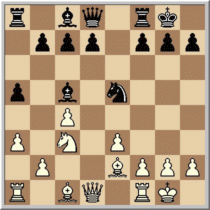Budapest Gambit
| a | b | c | d | e | f | G | H | ||
| 8th | 8th | ||||||||
| 7th | 7th | ||||||||
| 6th | 6th | ||||||||
| 5 | 5 | ||||||||
| 4th | 4th | ||||||||
| 3 | 3 | ||||||||
| 2 | 2 | ||||||||
| 1 | 1 | ||||||||
| a | b | c | d | e | f | G | H |
The Budapest Gambit after 2.… e7 – e5
The Budapest Gambit is an opening of the game of chess . The Budapest Gambit is a closed game and is based on the Indian Defense . It starts with the following moves:
- 1. d2-d4 Ng8-f6 2. c2-c4 e7-e5 3. d4xe5 Nf6-g4
If Black continues instead of 3.… Nf6 – g4 with 3.… Nf6 – e4, the result is the Fajarowicz gambit , which some authors regard as a sub-variant of the Budapest gambit. Opening theory classifies the Gambit under the ECO codes A51 and A52.
After 1. d4 Nf6 2. c4 e5 Black has a developmental advantage. In addition, White has weakened his black squares with 2. c4, which is reinforced by the relatively frequent exchange of black-squared bishops. The Budapest Gambit is played relatively rarely, as White has the opportunity to gain a small but permanent advantage without risk by giving back the extra pawn. However, if he tries to keep the pawn, he has to be prepared for a sharp game.
The main variants are:
- 4. Bc1 – f4 Nb8 – c6 5. Ng1 – f3 Bf8 – b4 + 6. Nb1 – d2 Qd8 – e7 7. e2 – e3 ( Karpow )
- 4. e2 – e4 ( Alekhine )
- 4. Bc1 – f4 Nb8 – c6 5. Ng1 – f3 Bf8 – b4 + 6. Nb1 – c3 Qd8 – e7 7. Qd1 – d5 (tries to keep the pawn)
- 4. Ng1 – f3 Bf8 – c5 5. e2 – e3 Nb8 – c6 The safeguarding of Bc5 after 6. a3 a5 enables a later maneuver of the black queen's rook over a6
With 2. Ng1 – f3 (and later c2 – c4) White can indeed avoid the Budapest Gambit, but on the other hand sets his king knight on the development square f3.
history
For the first time turned Géza Maróczy the Budapest Gambit in a master batch 1898: In Budapest he won against Eagle with Black in the 19th train. In 1907 Adolf Albin lost to Perlis in Vienna , in 1911 Krejcik won in Vienna after 17 moves.
The tournament in Budapest in 1916, when Gyula Breyer won against Johannes Esser on move 31, is considered to be the birth of this opening .
As a result, even the strongest players of the time, such as Milan Vidmar , Jacques Mieses , Carl Schlechter , Richard Réti , Max Euwe , Savielly Tartakower and Alexander Alekhine , used the gambit successfully.
The Fajarowicz gambit (3.… Ne4) only found attention after the game Herman Steiner - Sammi Fajarowicz (Wiesbaden 1928).
literature
- Otto Borik : Budapest Gambit. 2nd Edition. Edition Müller, Düsseldorf 1988, ISBN 3-7919-0221-0 .
- Anatoly Mazukewitsch: Attacking with Budapest Gambit. Sport-Verlag, Berlin 1993, ISBN 3-328-00587-0 .
- Viktor Moskalenko : The Fabulous Budapest Gambit. Much More Than Just a Sharp Surprise Weapon. New In Chess, Alkmaar 2007, ISBN 978-90-5691-224-6 .
